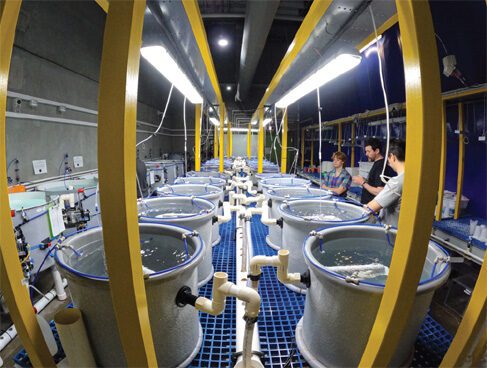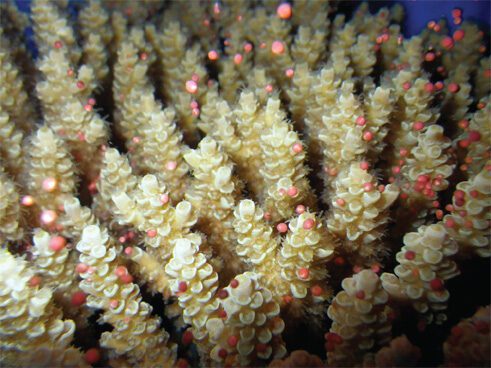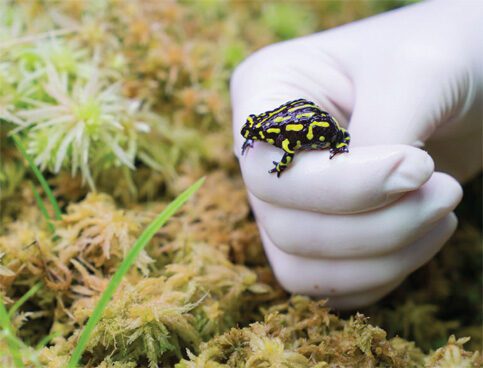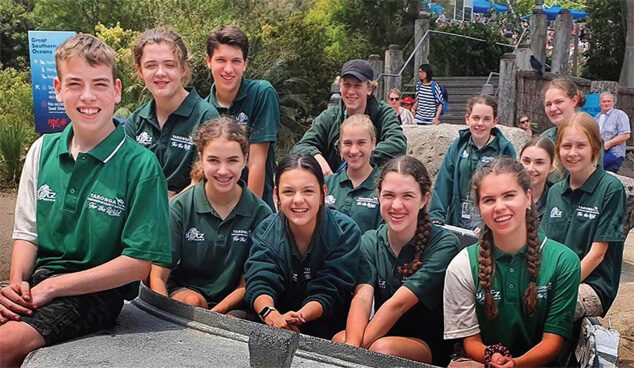As climate change becomes the world’s most important issue, North Shore Living goes behind the scenes to find out what Taronga Zoo is doing to save the planet. Alex Driscoll reports
Research and education have long been the cornerstones of zoos, from medieval menageries to the sprawling complexes found in major cities worldwide. However, in the 2020s, many zoos are beginning to recognise the role they can play in not only education but also conservation, preservation, and setting the standard for addressing the climate crisis.
Taronga Zoo had this mission front and centre at Sydney’s most recent Climate Action Week in March. With the growing threat of climate change, the preservation and conservation of species is becoming increasingly complex. One person at Taronga who understands this better than most is wildlife conservation officer Michael McFadden. “We have seen the impacts of climate change mostly through more extreme (weather events)”, Michael said during a panel discussion. Michael, who is involved in one of Taronga Zoo’s flagship programs to save the corroboree and booroolong frogs from extinction, recalls how a severe drought from 2018 to 2020 forced the zoo to evacuate the entire local population of the booroolong frog to save the species.
Speaking to North Shore Living, Michael elaborates on how climate change, as well as other man-made impacts, has made the job of conservation significantly more difficult.
“If there is a climatic event like a bush fire, or a major drought or a significant flood, (native species) tend to bounce back quite readily,” the conservationist explains. “Unfortunately, for species that are being impacted by other threats as well (such as habitat loss, introduced predators and diseases), major climatic events are harder to recover from.”
A prime example of this is the blight of chytrid fungus, an introduced disease in Australia that has caused havoc on the corroboree frog. Like any fungus, this deadly amphibian infection thrives in moist and aquatic environments, and its presence rapidly increases during floods. With the increased number of floods, which many experts cite as a telltale sign of climate change, chytrid fungus has been able to thrive.
However, with these challenges, it appears that Taronga is adapting as well, finding new ways its research and conservation can continue despite new hurdles. One space where this is evident is in its extensive breeding and sperm preservation programs.

Coral larval tanks
Located in Taronga’s new education and research centre is a small lab, unremarkable apart from two large canisters containing the cryo-frozen semen of hundreds of species. Guided by conservation scientist leader Justine O’Brien, Taronga has extended its conservation reach well beyond the animal kingdom, focusing a lot of effort on restoring and maintaining coral reefs.
Mass coral bleaching events have become one of the most publicly discussed impacts of climate change in Australia. Every year, these bleaching events destroy a large chunk of the Great Barrier Reef. Coral bleaching is when the coral, due to stressful environmental conditions, causes the organisms to expel the symbiotic algae that live in their tissue. Without these algae, the coral not only loses its colour but becomes vulnerable to disease and starvation.
“The coral essentially can’t tolerate that elevated heat,” Justine explains. “Like having a fever if you’re a mammal, there’s only so much time you can go through that elevated heat period before you start to shut down.”
Generations-old reefs can die out in a matter of days. Such large amounts of coral being wiped out in one area makes breeding nearly impossible, rendering some reefs functionally extinct. The knock on effect is that fish which live in the reef have nowhere to feed, breed and live – causing further stress on many species.

Spawning coral in the zoo lab
The need to maintain these reefs despite climate change has led the team at Taronga to conduct expeditions across Far North Queensland, collecting sperm and eggs from breeding corals. This genetic material is then stored at the zoo, where insemination can take place. Coral is then grown on innovative little 3D-printed disks that stop fish that eat coral from being able to access it, where it is then re-introduced into the wild, particularly in locations impacted by mass bleaching events.
As highlighted by Justine during the panel, early experiments and results have been positive: “Fresh off the press is that results are showing that the coral are growing and surviving, so we’re really excited.”
Taronga Zoo also seems to be well aware of the impact that climate change can have on humans and cultures. While speaking on the climate week panel, Justine highlighted the deep cultural ties local First Nations people have to coral reefs: “Many communities rely on reefs for their livelihoods. Aboriginal and Torres Strait Islander peoples have deep connections to the reef, and knowledge that spans tens of thousands of years.”
The tireless work done by Taronga Zoo in the field of conservation is vital and has helped lease a second life to some species who, due to climate change, may have gone extinct. However, there is only so far this work can go. When asked if conservation is getting more difficult because of climate change, Michael offers a simple answer: “In short, yes.

The critically endangered corroboree frog
“Where things like major droughts (previously) only occurred every 50 years, they are now more frequent, meaning we have to intervene (more often).”
However, it is within this space of addressing climate change that Taronga Zoo has found a new niche it can fill: setting an example and advocating for greater climate action. And it appears this tactic might be working. Many of the people in attendance of the climate action week event were from the corporate and government world.
The zoo’s effort to set an example extends to being a model business for sustainability. A tour of Taronga’s facilities highlighted this. The zoo is carbon neutral, relying on almost entirely renewable sources. It is strict on supply chain, requiring brands that want items stocked in the zoo, from drinks to souvenirs, to demonstrate their climate credentials. They have also turned an eye to their local environment, taking measures to minimise their impact on nearby Sydney Harbour, such as using soap-free detergents in water and restoring nature corridors.
However, perhaps the most important thing Taronga Zoo does is outreach and advocacy. Belinda Fairbrother, community impact and guest learning manager, highlighted the importance of communicating Taronga’s example to the broader public. One particularly effective tactic is what Belinda labels ‘pester power.’

Taronga runs a very popular Youth at the Zoo program
“We can create moments of learning on-site for children,” Belinda states, explaining what ‘pester power’ is. “They go back into their environment, whether it’s their home or their school, and they can tell their mum and dad or their friends or whoever will listen about what we are doing here and what they can do,” she adds. This causes a ripple effect, which Belinda labels using ‘the dark arts of marketing’ for good.
Youth engagement is a core theme of the zoo’s outreach and advocacy. The Youth at the Zoo program is one of these initiatives, which over its 25 years has aimed to create environmentally conscious leaders who can go into the world ready to make a difference. Through education programs that focus on leadership, communication skills and building advocacy skills, Taronga has its eyes firmly on the future.
A frequently repeated idea during the panel and tour is that Taronga is focused on not just animals, but ‘nature’ as a whole. Animals cannot be properly conserved without a suitable environment, and suitable environments cannot be sustained if the climate is changing as rapidly as it is. Taronga recognises this, offering a great representation of the changing missions of zoos globally.
“If you’ve got nature outcomes, you’re going to have climate outcomes,” panellist Andrew Elphinstone explains. “And if you’ve got climate and nature outcomes, you are going to change the world.”








